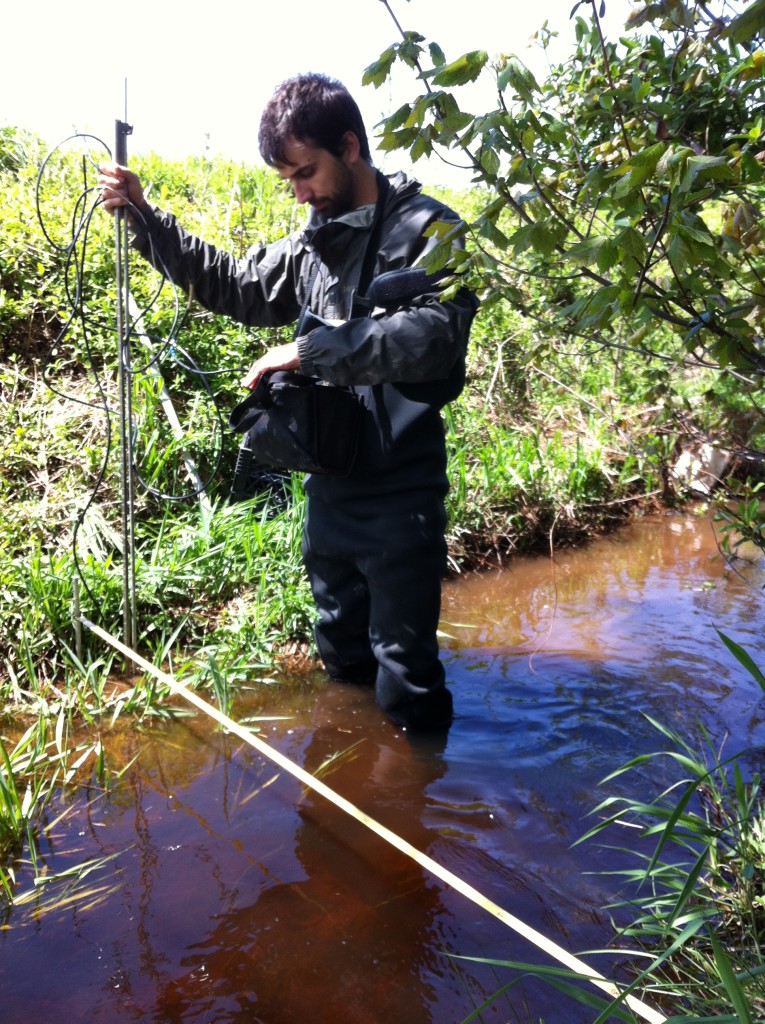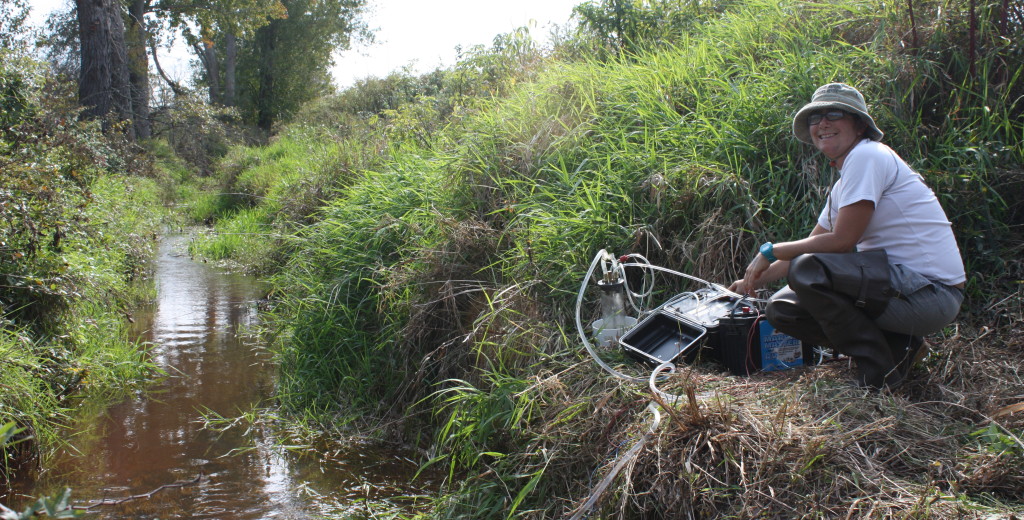by Kristen Minogue

Tom Jordan beside a V-shaped weir that tracks nutrients in a SERC stream. (SERC)
For years, a team of scientists has been trying to solve a mysterious disappearance at a drainage ditch on the Choptank River Basin, on Maryland’s eastern shore. Every year roughly 32,000 pounds of human-generated nitrogen enters the ditch’s watershed, from fertilizers, air pollution and other sources. But less than a third of that nitrogen typically flows out of the stream.
Tom Jordan has seen it before. A nutrient ecologist at the Smithsonian Environmental Research Center (SERC), Jordan has wrestled with the mystery of the missing nitrogen for more than twenty years.
“It feels like a sort of fatal attraction,” Jordan said. Two decades of trial and error and dead ends only fueled his determination to find answers. Now, according to a new January study, Jordan and his colleagues finally have some.
Into Thin Air
Jordan first discovered the riddle in the mid-1990s. He and SERC ecologist Don Weller were calculating nitrogen budgets for East Coast watersheds, part of a larger international project.
“What we came up with, when we looked at how much nitrogen we put in the watershed and how much comes out, totally blew our minds,” Jordan said. Of all the nitrogen going in, only about 20 percent left.
The scientists, not at all jokingly, concluded the missing nitrogen had vanished into thin air. It’s called denitrification: Nitrogen in the watershed had turned into nitrogen gas.
When nitrogen soaks into the ground, microbes often convert it to nitrate (NO3). In the Chesapeake, nitrate can cause algal blooms, dead zones, and fish kills. But when conditions are right, other oxygen-hungry microbes underground break nitrate apart for its oxygen atoms, until it escapes as harmless nitrogen gas (N2).
It was a simple explanation. However, it was nearly impossible to prove in the field.

Graduate student John Gardner measures discharge in a stream in the Choptank. (courtesy of Tom Fisher Lab)
Tracking the Unseen
Denitrification is invisible. That makes it difficult to detect, let alone measure. “You can’t actually see anything that’s happening. You can’t see where the nitrogen is moving, where it’s getting denitrified,” said John Gardner, a graduate student now at Duke and lead author of the study.
It doesn’t help that the atmosphere is over three-fourths nitrogen.
“The background is enormous,” Jordan said. “It’s easy to measure in the laboratory…but out in nature, in the real environment, it’s hard.” At first, Jordan and his colleagues attempted to solve the problem at SERC by filling chambers with acetylene gas, forcing denitrifying microbes to make easier-to-measure nitrous oxide gas. But that only examined soil, and didn’t generate much of a response.
They had one stroke of luck: Jordan found two farmers willing to let the team do research on their land—something not all famers are open to doing. And so they arrived at the Choptank.
While working on the Choptank, Jordan’s lab joined Tom Fisher, a nutrient ecologist at the University of Maryland’s Horn Point Laboratory. With Marilyn Fogel of the Carnegie Institute and Mark Altabet at the University of Massachusetts, they tried measuring different nitrogen and oxygen isotopes (heavier vs. lighter atoms) in nitrate. When that proved problematic, Jordan and Fisher started measuring escaping nitrogen gases through stream water, by pumping propane into the stream and measuring its escape rate. But this was a complicated, error-prone approach, and hauling backyard-barbecue propane tanks was a nuisance.
“We’re talking about places where you may have to park the car and walk a quarter of a mile to get to your sampling site,” remembered former SERC postdoc Karen Knee.
Meanwhile, with one year left in their grant, time was running out. “We had one year to make this thing work,” Jordan recalled.
Knee suggested another gas: radon. Groundwater contains radon naturally, so they didn’t need to inject anything. More importantly, radon in the atmosphere is essentially zero—so no background to throw off their calculations. After tracking how quickly radon escaped the water, a fast mathematical conversion calculated the escaping nitrogen.
Jordan’s team had finally cracked the code.
The Missing Nitrogen
The scientists’ first guess had been right: Much of the nitrogen was vanishing into thin air, as nitrogen gas escaping the stream. Denitrification accounted for a stunning 117 percent of the missing nitrogen, reported the January study.
If 117 percent seems impossibly high, there are a couple explanations. The escaping nitrogen could include nitrogen from years or decades past, said Knee. Nitrogen can linger in groundwater a very long time. The year they took data was also exceptionally wet. Because more nitrogen flowed out of the stream that year, there was less missing nitrogen to account for. In a more normal year, Jordan estimates the figure would be lower: Denitrification through stream water would perhaps account for a third of the missing nitrogen.
More surprising was where denitrification occurred. In the Choptank ditch, most denitrification happened not in the stream, but the groundwater—a source largely overlooked.
“Groundwater is a resource that we should take advantage of,” said Gardner, as it could help reduce nitrogen entering the Bay.

Karen Knee measures radon by the Choptank drainage ditch. (SERC)
But not all escaping nitrogen becomes harmless nitrogen gas. A very small amount becomes nitrous oxide (N20), a greenhouse gas up to 300 times more powerful than carbon dioxide.
Before nitrate becomes nitrogen gas, microbes transform it into nitrous oxide. But sometimes—especially in nitrogen-polluted streams—the reaction stops there. If plenty of fresh nitrate enters a stream, the reaction tends to halt at nitrous oxide.
What about the remaining missing nitrogen that’s not denitrified? Scientists have a few guesses. It could go into plants, microbes or other organisms. It may also accumulate in soil or groundwater. However, Jordan said, watersheds’ ability to store nitrogen may be limited.
Measuring nitrogen’s escape through streams likely misses some denitrification, Jordan added. Nitrogen could also escape from soil. Pinpointing denitrification “hot spots” could reveal more ways to keep it out of the Bay. But for now, the team has nailed down where at least some of the missing nitrogen has gone.
“This has been like a holy grail kind of thing for me,” Jordan said. And the quest isn’t over yet.
Hunt for a Missing Nutrient: Part I
Hunt for a Missing Nutrient: Part II


So, what can we do in our streams to make sure the denitrification process doesn’t stop at nitrous oxide -is this about certain plants being strategically placed in the streams to encourage certain behavior?
And where’s the tie-in for action as it relates to connecting more to groundwater and how it helps? What can we do there?
Great article! Thanks!
Good questions! For your first question, one of the best ways to increase a stream’s ability to emit nitrogen gas (N2) instead of nitrous oxide (N2O) is to cut nitrate pollution in the stream (NO3). The reason is that microbes get more energy by removing oxygen from nitrate than nitrous oxide. If a stream is loaded with nitrate, microbes would generally rather work with nitrate than nitrous oxide. But if a stream has less nitrate, they’re forced to work with nitrous oxide instead, turning it into nitrogen gas. There are lots of ways to reduce nitrate pollution, such as using no more fertilizer than necessary, planting cover crops and putting riparian buffers between farm fields and streams.
For your second question, groundwater is good at denitrification because it transports water to places with no oxygen and plenty of organic carbon, where denitrification can occur very easily. As an action item, we can optimize the land around those sites so they can do as much denitrifying as possible. We’re still figuring out which landscape features are most conducive to denitrification (certain soil types, elevation, or bacteria). Once we do, that will give us some guidance on how to best take advantage of groundwater’s capabilities.